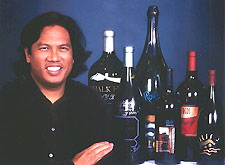|
from the Melting Pot of the Pacific
Well, the following discourse is based upon the latter principle, and some of our own tried-and-true experiences -- many of which debunk what the "experts" say about the way wine goes with food. Here are just a few of those "myths," along with the realities: That Lighter Style "Food Wines" Are Excuses for Weak, Inferior Wines - Ludicrous. If you take a look at the wines of the world with the longest track records in the context of regional cuisines -- Chianti in Tuscany, Sancerre in France, Rioja in Spain, and even the various pink, white and red wines of the French and Italian Riviera -- you can see that they're all light, easy to drink, and relatively lacking in the taste of oak and the feel of high alcohol which characterizes most of the "serious" wines of today. Just because a wine is light in body and flavor doesn't make it inferior. The fact is, lighter, less expensive wines are most likely to go better with food -- which in most people's book would make them "better." That Higher Acid Wines Are Best with Food - Wines with crisp, lemony sharp acidity can indeed compliment food -- especially if you're having plainly cooked fish, which an acidic white wine can zest up like a squeeze of lemon. But put that same fish in a buttery sauce or rich, creamy, slightly salty shellfish stock reduction, and all of the sudden a high acid wine tastes thin and puckery, and the dish tastes oily and filling. In other words, low acid wines have as much a place with food as high acid wines. In fact, most of the wines of Italy and Southern France are fairly low in acid, and "fat" with fruitiness -- which only makes sense with foods driven by the taste of olive oil, plump beans and nostril tingling garlic. That Big, "Oaky" Chardonnays Don't Go with Food - There are actually a lot of dishes with which a fuller bodied wine with the rich taste of oak -- a vanillin or creamy, often smoky or even "charred" taste -- would do a lot better than a lighter, pure fruit style of wine. Smoked or wood grilled meats, for instance, love an oaky wine. California style Chardonnays tend to be quite full and richly oaked to the point of tasting "buttery" -- perfect for your everyday roasted chicken, dripping in naturally buttery, fatty juices. Sweetbreads in cream, veal osso buco in freshly herbed jus, wood grilled swordfish with fruit salsa -- the list of Chardonnay-friendly dishes goes on and on. In fact, there probably is no better wine for a holiday turkey -- especially if cooked in a charcoal or wood roaster and stuffed with sage, bread crumbs, and even seafood sausages or oysters -- than any number of these "big, fat mamas," as David Rosengarten once described California's unique style of Chardonnay. That Sweet Wines Interfere with the Taste of Food - In many cases, yes. But in many other cases -- a sweet/sour Chinese dish, chili-spiked Thai food, a sugar laced BBQ sauce, or even a pizza with caramelized onions -- wines with a little sweetness, such as a Johannisberg Riesling or White Zinfandel, are a better balanced match than completely dry wines. Especially when dishes are hot and spicy -- in which case, slightly sweet wines can cool and freshen the palate. That Salads and Vinaigrettes Are Bad for Wine - Leafy greens tossed in harsh, acidic cider vinaigrettes are no good, with or without wine. But vinaigrettes made with soft, round, aromatic fine vinegars -- such as balsamic, sherry, or rice wine vinegars -- actually enhance, and liven up, the taste of wine. Throw in lush, vine ripened tomatoes, sweet Maui onions, and Roquefort, and you've got a fine match with off-dry Riesling and Chenin Blanc, or well chilled pink wines made from Grenache or Zinfandel. With fresh herb crusted goat cheese, it's hard to beat a crisp, dry Sauvignon Blanc. Throw whole grain mustard into the dressing, and top things off with shredded duck or slivers of cold beef, then light, fragrant reds such as Pinot Noir come into play. The bottom line is that when it comes to salads, the choice of wine is as endless as what you put in them. That the Richest Foods Need the Richest Wines - This thinking will take you only so far. It works for red meats -- Cabernet Sauvignons, for instance, are just right for fatty beef and lamb dishes. But with things like lobster, shrimp, crab and other sweet shellfishes, fairly light dry whites -- such as Fume Blanc, Pinot Blanc, Pinot Gris or Pinot Grigio -- tend to make a fresher combination than thick, heavy Chardonnays. With spicy hot Asian foods, full bodied, dry Gewurztraminers taste harsh and bitter; whereas delicate Rieslings and medium sweet, low alcohol Italian Muscats bring out the flavor, rather raw heat, of exotic, spicy seasonings. That Chocolate Is an "Enemy" of Wine - Anyone who hasn't had a Ruby or Tawny Port with dense, bittersweet chocolate just hasn't lived. It's true that chocolate wreaks havoc on things like Champagne and sweet white wines, but sweet, fortified red wines handle -- in fact enhance -- the taste of chocolate with aplomb. Other sweet reds of this type include black, juicy Banyuls from France, sticky rich "Malmsey" Madeira, and the occasional "varietal" Ports (such as Justin's Cabernet-based "Obtuse") from California or Australia. And these are not things to think about -- but to just eat, drink, and make merry! June 16, 1999
|
 The Truth About Wines & Foods
The Truth About Wines & Foods